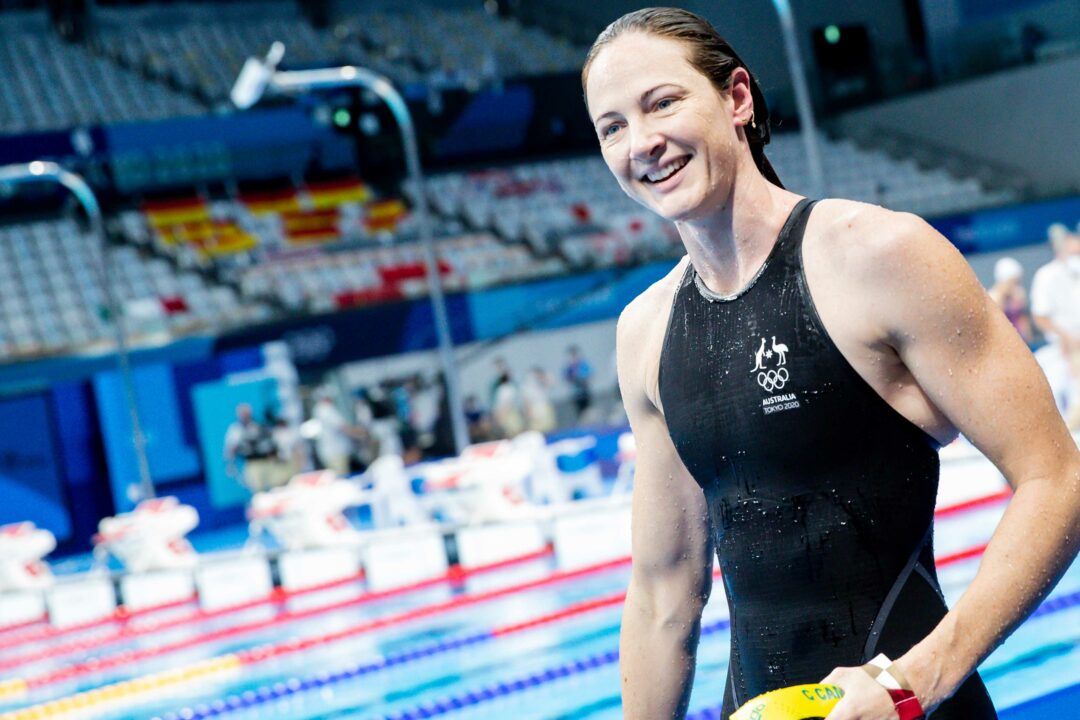Take a look at the results of some swimming races of the last Olympic Games, and you probably will have little doubt that swimming is a sport for tall athletes.
According to the World Health Organization: “The expected average height of a healthy population should be 163 cm for women and 176.5 cm for men.” In fact, it would be very difficult to find an Olympic medalist below those figures in recent Olympics, which reinforces the motto: elite-level swimmers are above average in terms of height.
In fact, at the Tokyo Olympics, Japan’s Tomoru Honda, the bronze medalist in the men’s 200 fly, was the only male swimmer to win a medal in an individual event being under 1.80 m tall (he is 1.72 m – 5 ft 8 in). On the women’s side, there were only two swimmers who won medals in individual events being under 1.70 m tall: Canadian Maggie MacNeil and American Hali Flickinger.
It seems obvious. Height helps swimmers swim the fastest. Having a length advantage gives them more surface area to propel themselves forward with.
A few days ago, this article discussed the tallest male Olympic swimming medalists. Instagram’s Swimming Stats page has also published the list of the tallest Olympic swimming medal winners in women’s individual events since 1960.
View this post on Instagram
Interestingly, Costa Rican sisters Sylvia and Claudia Poll are the tallest swimmers to do so, being the only swimmers in Olympic history over 1.90 m tall (6 ft 3 in) to win medals in individual events.
They are the only Costa Rican Olympic medalists in history. Sylvia won the silver medal in the 200 freestyle in 1988. Eight years later, Claudia won the only gold medal for Costa Rica in the same event. She also won two bronze medals in 2000.
Claudia Poll was part of the tallest podium ever seen in Olympic swimming history on the women’s side. In the women’s 200 freestyle at the 1996 Olympics, the medalists were Poll (1.90 m), German Franziska van Almsick (1.81 m), and German Dagmar Hase (1.83 m). They combined for an average height of 1.85 m.
Note that on this list we have some sprinters (for example, Katrin Meissner, Cate Campbell), long distance swimmers (Astrid Strauss, Alessia Filippi), backstrokers (Missy Franklin, Jolanda de Rover) and flyers (Otylia Jedrzejczak, Dana Vollmer), but no breaststroke nor individual medley swimmers. Which makes sense, since breaststroke and individual medley events are more technique based. Breaststroke in particular places more emphasis through the middle of the hip, as opposed to the length of the body, more necessary in freestyle and backstroke.
At the Tokyo Olympics, Australian Cate Campbell was the tallest swimmer to win a medal. Being 1.86 m tall (6 ft 1 in), she won the bronze medal in the women’s 100 freestyle. Penny Oleksiak, bronze in the 200 free, was another tall simmer (1.85 m) who won a medal in Tokyo.

Height is one factor only. I think the swimming world does itself a disservice by creating this height hierarchy. It chases away talented athletes who could make the swimming even more exciting by finding innovative ways to get faster. For example, a longer body travels faster on the surface while a shorter body travels faster underwater. The Japanese swimmers have demonstrated innovation very effectively.
Can you publish the shortest swimmers to give short people hope ?
And just to motivate any “shorties” out there reading this article, Libby Trickett (Lenton) at 5ft 6″ broke the world record for the 100 free and the 100 fly twice each in her career.
She was short for an elite swimmer but she had pretty long arms as I recall. I don’t think she broke any world records in the 100BF, at least not in LCM.
She broke 50m and 100m Free, and 100m and 200m Free SC WRs I think….and was 100m BF Olympic Champ. She had a short and powerful physique.
“It seems obvious. Height helps swimmers swim the fastest. Having a length advantage gives them more surface area to propel themselves forward with.”
Another way to look at it: It is but one variable of many. It’s an undeniably important variable because, all things equal, a taller swimmer is going to have the advantage over a smaller one. That being said, I’m sure everyone who has been around the sport long enough remembers a diminutive teammate who went far beyond in their swimming career because they showed up every day and did the work. Likewise, I’m sure we can all think of a swimmer who had every God-given tool available to them in terms of physicality but never made it… Read more »
It’s also important to remember that the success of your swimming career isn’t determined by winning an Olympic medal. I’m 4’11” and swim Division III. Even in my ideal swimming reality I probably wouldn’t have been good enough to swim D1. For most of my swimming career I didn’t think I’d swim in college. But even if I didn’t that wouldn’t have meant my swimming career was unsuccessful.
The Japanese National Team has entered the chat.
I’d be interested in seeing articles showing the shortest men and women medalists.
Tennis is another sport that favours tall women- and world Number 1 Ash Barty is 166cm / 5foot5!
Instagram isn’t loading. Can we get this image posted here?
Facebook, Instagram, Whatsapp – they’ve been down for hours.
Dutch Olympic champion from 1968, Ada Kok, was well over 6’1″ tall which was quite rare back then. Then again, the Dutch are one of the tallest nations in the world according to graphs and studies.